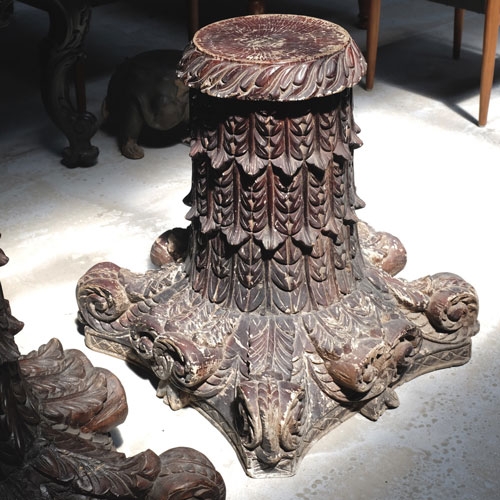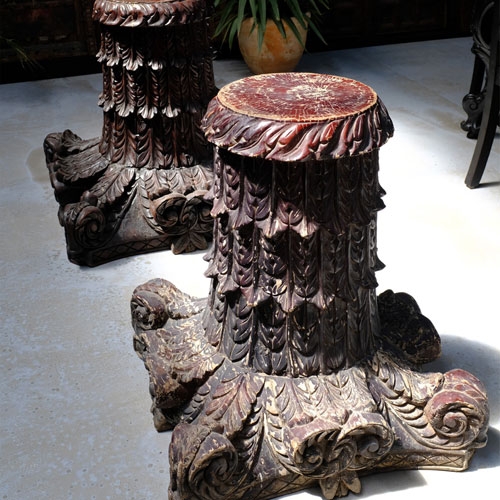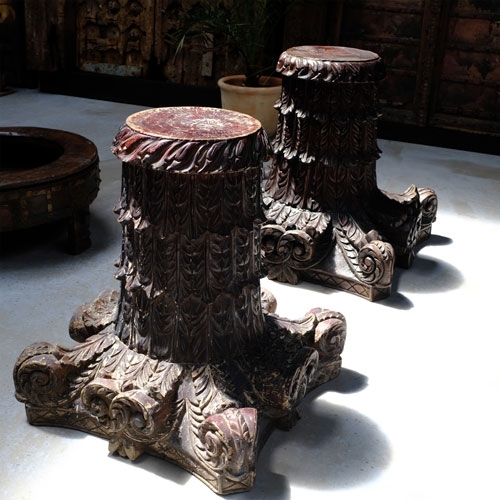You have no items in your quote list.
- Home
- Seating for Hire
- Antique Corinthian Column Base
Details



The story behind these hefty Indo-Corinthian columns goes further back than one would imagine. The lush Acanthus leaves folding outwards at the top and the frieze design following its unfurling have not always been native to the subcontinent. It was only when Alexander the Great reached the end of his East-bound military journey around 2000 years ago (approximately 356 BCE), that such Hellenistic influences began to enter Indian and South-Asian art, creating a new stylistic vocabulary altogether now known as Gandharan Art.
The columns here follow the rather more ancient Indian temple architectural form of constructing columns with wood, before the advent of stone architecture. They have been weathered but the elements most likely the sun in this case, as can be seen by the wear and tear.
The word Corinthian describes an ornate style of columns developed predominantly in ancient Greece as one of the Classical orders of Architecture. As is prevalent in these pieces, these columns are decorated with Acanthus leaves and flowers, with ornamentation eventually flaring outwards. For the Greeks, the Acanthus plant represented immortality, rebirth, and resurrection, and was often rendered in great detail in carvings. Such Corinthian styles were later also found in Islamic architecture, which could be one of the reasons why despite the fading of brief Indo- Greek art, such columns survive in Indian architecture until now.
This Hellenistic influence began taking root in the historical zone which stretched north to Bactria in Central Asia, and South as far as Peshawar and the greater Swat Valley. Soon these influences reached as far as the ancient cities of Pataliputra and Vidisha, among others.
At the height of Indo-Greek or Gandharan art, these columns began to be commonly used in combination with Buddhist architectural elements such as Stupas. As a unique kind of Greco-Buddhist fusion, such columns often incorporated figures of the Buddha or Bodhisattvas under the foliage design of the Corinthian. In the Greco-Buddhist tradition, certain elements would then be elongated - just as one observes on the frieze in this column.
Such Indo-Corinthian columns have been excavated from sites like the Jamalgiri monastery, Peshawar, and Taxila. One or another form of a Corinthian order has been found in almost all Buddhist remains of the Indus Valley, Afghanistan, and parts of North-Western South Asia. Rather than plainly imitating Greek styles, these emerged from combining other forms as well, for Corinthian-like orders or classes were not uncommon to Indian temple architecture before, such as the Corinthian-like Chitra Skambha style.
The columns at the time of Gangharan art, and even in the case of Greek or Roman columns, have largely been made out of stone, or cement. Despite changes in patronage, or religious affiliations, the Indo-Corinthian column became a common site for the ornamentation of monuments and buildings. Even today, one can spot government buildings or monuments across hosting these ancient Acanthus leaves which made such lengthy journeys to reach the sub-continent.
Additional Information
| Size | No |
|---|---|
| Height | No |
Wow Rentals is a South East based specialised event furniture hire company , we have a wide range of furniture at great prices. We supply within London as well as the East, South East & Midlands.
Add the Wow Factor to your events, contact us to meet your contemporary event furniture needs. We cater for all types of events from corporates to smaller events
Wow Rentals
Our Favorites
Artificial Tree Hire
Like us for updates
Wow London T/A Wow Rentals, 10 Harland Ave, Croydon, CR0 5QB. All Prices are Ex-Vat. Company number: 09056521 Contact Us

